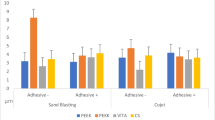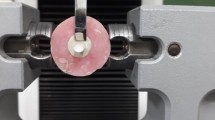Abstract
Objective
The study aimed to analyse the shear bond strength of computer-aided design and computer-aided manufacturing (CAD/CAM) polymethyl methacrylate (PMMA)- and composite-based polymer materials repaired with a conventional methacrylate-based composite after different surface pretreatments.
Methods
Each 48 specimens was prepared from six different CAD/CAM polymer materials (Ambarino high-class, artBloc Temp, CAD-Temp, Lava Ultimate, Telio CAD, Everest C-Temp) and a conventional dimethacrylate-based composite (Filtek Supreme XTE, control) and aged by thermal cycling (5000 cycles, 5–55 °C). The surfaces were left untreated or were pretreated by mechanical roughening, aluminium oxide air abrasion or silica coating/silanization (each subgroup n = 12). The surfaces were further conditioned with an etch&rinse adhesive (OptiBond FL) before the repair composite (Filtek Supreme XTE) was adhered to the surface. After further thermal cycling, shear bond strength was tested, and failure modes were assessed. Shear bond strength was statistically analysed by two- and one-way ANOVAs and Weibull statistics, failure mode by chi2 test (p ≤ 0.05).
Results
Shear bond strength was highest for silica coating/silanization > aluminium oxide air abrasion = mechanical roughening > no surface pretreatment. Independently of the repair pretreatment, highest bond strength values were observed in the control group and for the composite-based Everest C-Temp and Ambarino high-class, while PMMA-based materials (artBloc Temp, CAD-Temp and Telio CAD) presented significantly lowest values. For all materials, repair without any surface pretreatment resulted in adhesive failures only, which mostly were reduced when surface pretreatment was performed.
Conclusions
Repair of CAD/CAM high-density polymers requires surface pretreatment prior to adhesive and composite application. However, four out of six of the tested CAD/CAM materials did not achieve the repair bond strength of a conventional dimethacrylate-based composite.
Clinical relevance
Repair of PMMA- and composite-based polymers can be achieved by surface pretreatment followed by application of an adhesive and a conventional methacrylate-based composite.

Similar content being viewed by others
References
Stawarczyk B, Ender A, Trottmann A, Özcan M, Fischer J, Hämmerle CHF (2012) Load-bearing capacity of CAD/CAM milled polymeric three-unit fixed dental prostheses: effect of aging regimens. Clin Oral Invest 16:1669–1677
Alt V, Hannig M, Wöstmann B, Balkenhol M (2011) Fracture strength of temporary fixed partial dentures: CAD/CAM versus directly fabricated restorations. Dent Mater 27:339–347
Göncü Basaran E, Ayna E, Vallitu PK, Lassila LV (2011) Load-bearing capacity of handmade and computer-aided design--computer-aided manufacturing-fabricated three-unit fixed dental prostheses of particulate filler composite 69:144-150
Güth JF, Zuch T, Zwinge S, Engels J, Stimmelmayr M, Edelhoff D (2013) Optical properties of manually and CAD/CAM-fabricated polymers. Dent Mater J 32:865–871
Stawarczyk B, Sener B, Trottmann A, Roos M, Ozcan M, Hämmerle CHF (2012) Discoloration of manually fabricated resins and industrially fabricated CAD/CAM blocks versus glass-ceramic: effect of storage media, duration, and subsequent polishing. Dent Mater J 31:377–383
Mörmann WH, Stawarczyk B, Ender A, Sener B, Attin T, Mehl A (2013) Wear characteristics of current aesthetic dental restorative CAD/CAM materials: two-body wear, gloss retention, roughness and Martens hardness. J Mech Behav Biomed Mater 20:113–125
Edelhoff D, Beuer F, Schweiger J, Brix O, Stimmelmayr M, Güth JF (2012) CAD/CAM-generated high-density polymer restorations for the pretreatment of complex cases: a case report. Quintessence Int 43:457–467
Güth JF, Almeida e Silva JS, Ramberger M, Beuer F, Edelhoff D (2012) Treatment concept with CAD/CAM-fabricated high-density polymer temporary restorations. J Esthet Restor Dent 24:310–320
Schweiger J, Neumeier P, Stimmelmayr M, Beuer F, Edelhoff D (2013) Macro-retentive replaceable veneers on crowns and fixed dental prostheses: a new approach in implant-prosthodontics. Quintessence Int 44:341–349
Vanoorbeek S, Vandamme K, Lijnen I, Naert I (2010) Computer-aided design/computer-assisted manufactured composite resin versus ceramic single-tooth restorations: a 3-year clinical study. Int J Prosthodont 23:223–230
Hickel R, Brüshaver K, Ilie N (2013) Repair of restorations—criteria for decision making and clinical recommendations. Dent Mater 29:28–50
Roos M, Stawarczyk B (2012) Evaluation of bond strength of resin cements using different general-purpose statistical software packages for two-parameter Weibull statistics. Dent Mater 28:e76–e88
Geigy Scientific Tables. 8th. 1980. Basel, Switzerland, CIBA-GEIGY
Rinastiti M, Özcan M, Siswomihardjo W, Busscher HJ (2011) Effects of surface conditioning on repair bond strengths of non-aged and aged microhybrid, nanohybrid, and nanofilled composite resins. Clin Oral Invest 15:625–633
Baur V, Ilie N (2013) Repair of dental resin-based composite. Clin Oral Invest 17:601–608
Brendeke J, Ozcan M (2007) Effect of physicochemical aging conditions on the composite-composite repair bond strength. J Adhes Dent 9:399–406
Ozcan M, Cura C, Brendeke J (2010) Effect of aging conditions on the repair bond strength of a microhybrid and a nanohybrid resin composite. J Adhes Dent 12:451–459
Stawarczyk B, Basler T, Ender A, Roos M, Özcan M, Hämmerle CHF (2012) Effect of surface conditioning with airborne-particle abrasion on the tensile strength of polymeric CAD/CAM crowns luted with self-adhesive and conventional resin cements. J Prosthet Dent 107:94–101
Bähr N, Keul C, Edelhoff D, Eichberger M, Roos M, Gernet W, Stawarczyk B (2013) Effect of different adhesives combined with two resin composite cements on shear bond strength to polymeric CAD/CAM materials. Dent Mater J 32:492–501
Özcan M, Pekkan G (2013) Effect of different adhesion strategies on bond strength of resin composite to composite-dentin complex. Oper Dent 38:63–72
Stawarczyk B, Trottmann A, Hämmerle CHF, Özcan M (2013) Adhesion of veneering resins to polymethylmethacrylate-based CAD/CAM polymers after various surface conditioning methods. Acta Odontol Scand 71:1142–1148
Ozcan M, Barbosa SN, Melo RM, Galhano AP, Bottino MA (2007) Effect of surface conditioning methods on the microtensile bond strength of resin composite to composite after aging conditions. Dent Mater 2007:1276–1282
Gajewski VE, Pfeifer CS, Froes-Salgado NR, Boaro LC, Braga RR (2012) Monomers used in resin composites: degree of conversion, mechanical properties and water sorption/solubility. Braz Dent J 23:508–514
Conflict of interest
The authors declare that they have no financial or other relationships that might lead to actual or potential conflict of interest. The major parts of this study were self-funded by the authors and their institutions. The polymer and composite materials used were provided by the manufacturers.
Author information
Authors and Affiliations
Corresponding author
Rights and permissions
About this article
Cite this article
Wiegand, A., Stucki, L., Hoffmann, R. et al. Repairability of CAD/CAM high-density PMMA- and composite-based polymers. Clin Oral Invest 19, 2007–2013 (2015). https://doi.org/10.1007/s00784-015-1411-x
Received:
Accepted:
Published:
Issue Date:
DOI: https://doi.org/10.1007/s00784-015-1411-x




